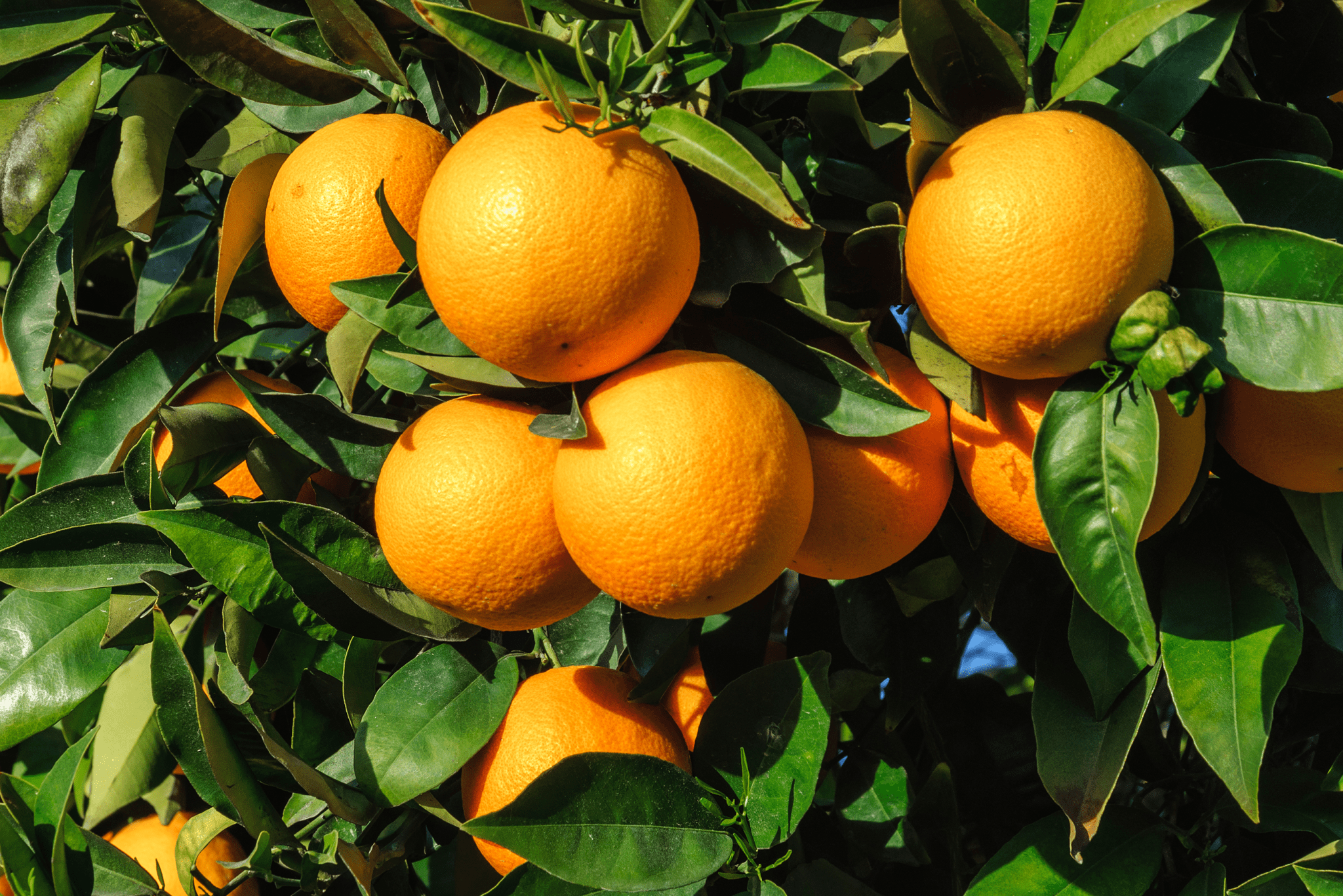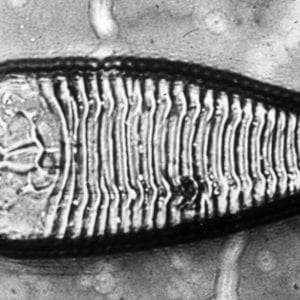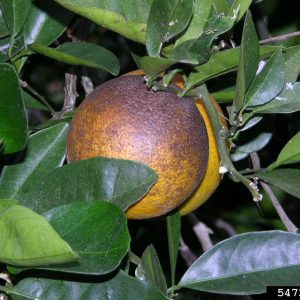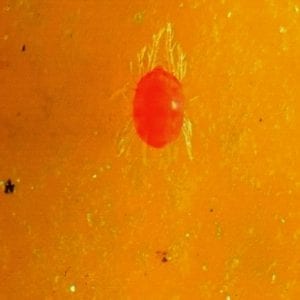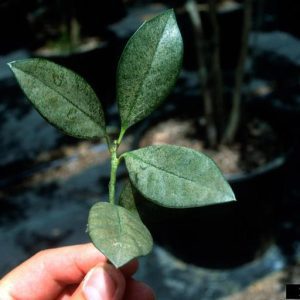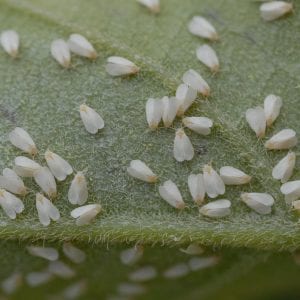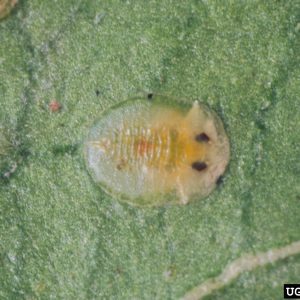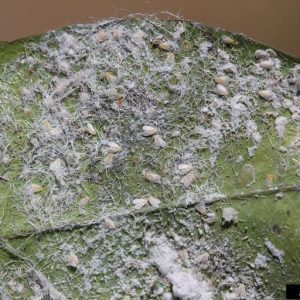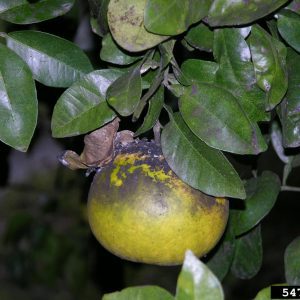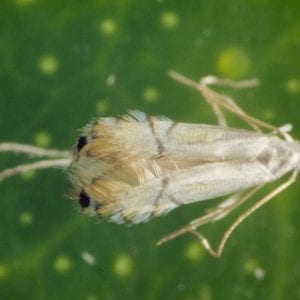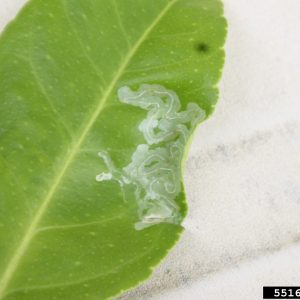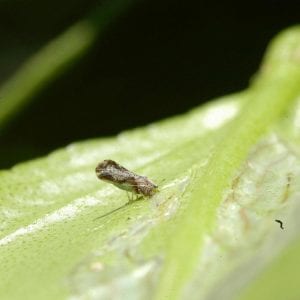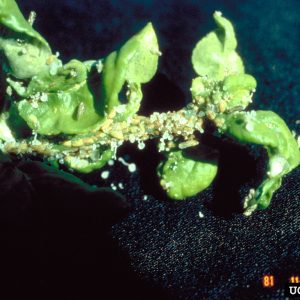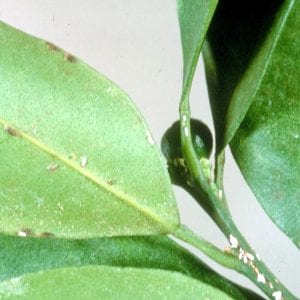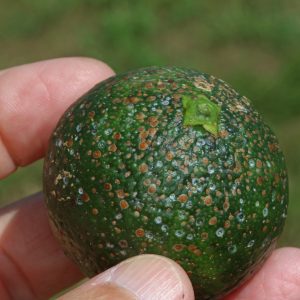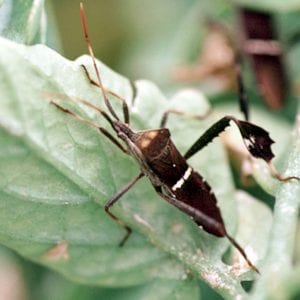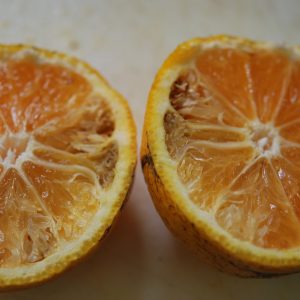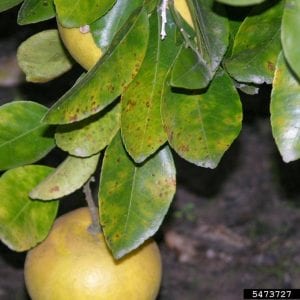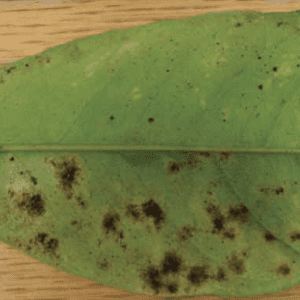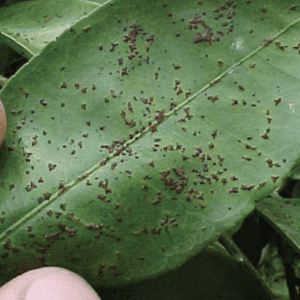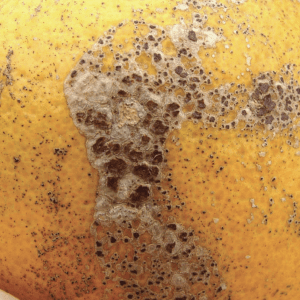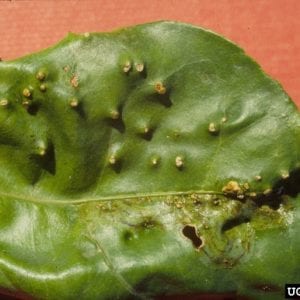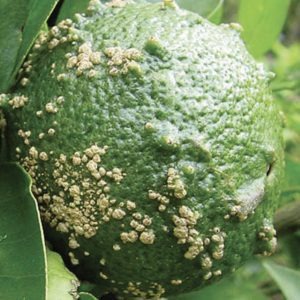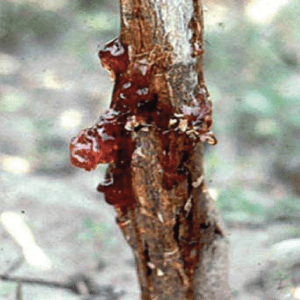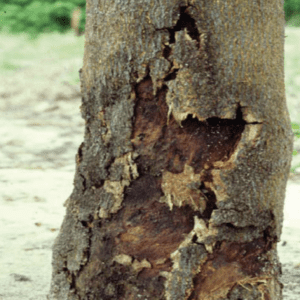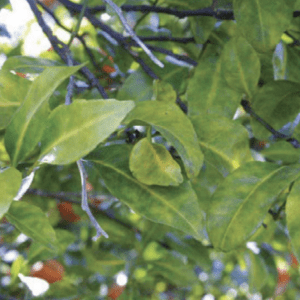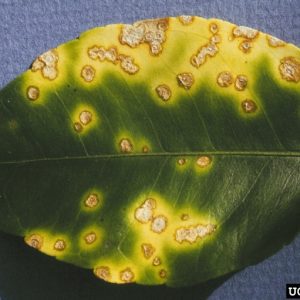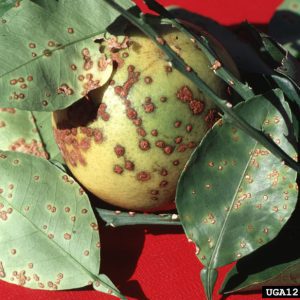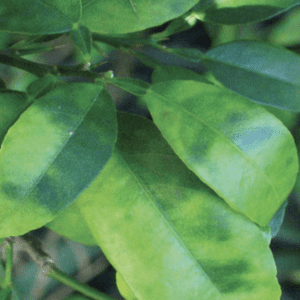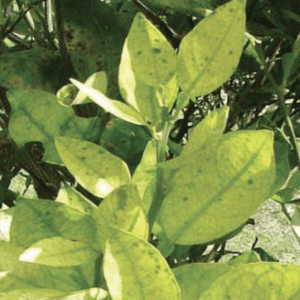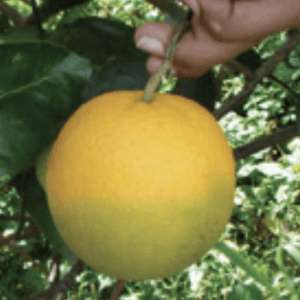Crop Production

Citrus has long been thought of as a low-maintenance crop. Though this crop is relatively low input, it is not hands free. Regular and timely scouting can keep the maintenance input to a minimum. This guide will provide you with a key to identify insect pests and diseases that may impact your production and beneficial insects that frequent the orchards. Insecticide and fungicide recommendations change along with the labels; always check the pesticide label before treating your crop. Insecticide and fungicide recommendations should be considered as suggestions; prepare a complete IPM plan for your orchard and keep good records of your insect pest issues.
Citrus Rust Mite, Phyllocoptruta oleivora
Citrus rust mites damage twigs, leaves, and fruit of citrus. Mites have piercing-sucking mouthparts. Adults have an elongated, wedge-shaped body and are approximately 0.13 mm long when mature. These mites are light yellow in color and difficult to see.
Fruit damaged by the citrus rust mite will have a tarnished brown/bronze appearance; internally fruit is not damaged. Populations usually peak from July to August.
Management tips: 435 oil can be used during the peak season for control of mites. Vendex, NeXter, or Agri-Mek may be necessary when populations are elevated.
- Florida Division of Plant Industry, Florida Department of Agriculture and Consumer Services, Bugwood.org
- Don Ferrin, Louisiana State University Agricultural Center, Bugwood.org
Citrus Red Mite, Panonychus citri
Citrus red mites are red in color and approximately 0.55 mm long. Females have an oval-shaped body, while males have a tapered, slightly smaller body. These mites are visible with the naked eye.
Mites puncture leaf cells and remove chlorophyll and nutrients, thereby reducing photosynthesis. Populations usually peak in late winter and spring.
Management tips: 435 oil can be used to control light infestations. Vendex, Portal, or Envidor can be used with heavy infestations of red mites.
- Jim Baker, North Carolina State University, Bugwood.org
- John Ruter, University of Georgia, Bugwood.org
Citrus whitefly, Dialeurodes citri
Citrus whiteflies are small, moth like insects that are approximately 1.2 mm long.
They feed on foliage, causing sooty mold growth on fruit, leaves, and twigs. Populations peak during late summer and early fall.
Management tips: Whitefly control can be achieved with 435 oil or insecticides such as Provado or Movento.
- Lyle Buss, University of Florida, Bugwood.org
- Florida Division of Plant Industry, Florida Department of Agriculture and Consumer Services, Bugwood.org
- Whitney Cranshaw, Colorado State University, Bugwood.org
- Don Ferrin, Louisiana State University Agricultural Center, Bugwood.org
Citrus leafminer, Phyllocnistis citrella
Adults are moths with iridescent scales and a black spot on each wing. Adults are only about 2 mm long.
Larvae leave mine-like tunnels on leaves. These tunnels can be an entry point for plant pathogens. Leafminers do not impact yield on mature citrus trees.
Management tips: For leafminer control on young trees, insecticides such as Provado or Agri-Mek can be used.
- Jeffrey W. Lotz, Florida Department of Agriculture and Consumer Services, Bugwood.org
- Mourad Louadfel, Bugwood.org
Asian citrus psyllid, Diaphorina citri
The Asian citrus psyllid is an exotic pest that is the vector of citrus greening disease.
Citrus greening is a serious disease that can shorten the life of infected trees. The disease is untreatable.
Management tips: Some insecticides can control the psyllid; these include Danitol, Mustang Maxx, Provado, and Movento.
- Natalie Hummel, Louisiana State University AgCenter, Bugwood.org
- INRA-Bordeaux, Institut National de la Recherche Agronomique, Bugwood.org
Scale, Coccoidea Family
Many types of scale insects can be found in citrus. This is a large family of insects that has a broad range of size and coloring.
Scale can be seen on the fruit, leaves, and stems. Once scale has hardened on the fruit it cannot be easily controlled or removed. Infested fruit cannot be effectively graded and sorted. Scale populations typically peak during late summer.
Management tips: Options include Provado and 435 oil.
- Central Science Laboratory, Harpenden, British Crown, Bugwood.org
Leaf-footed Bug, Leptoglossus phyllopus
Adult leaf-footed bugs have a flattened, leaflike appearance with a distinctive straight band across their dorsal sides. Adults are typically 5 /8 to 3/4 inch in length. Nymphs are similarly shaped but are much smaller and have bright orange bodies and black legs.
Leaf-footed bugs feed on blooms and fruit. Damage is similar to that of stinkbugs, leaving dry or rotten segments inside of fruit.
Management tips: Options include Danitol and Mustang Maxx.
- Ward Upham, Kansas State University
Greasy Spot, Mycosphaerella citri
Leaf symptoms initially appear as yellow spots on the upper leaf surface, with brown blisters on the underside of the leaf. As the leaf ages, the lesions become darker brown with a greasy appearance. Severely affected leaves will drop. Fruit symptoms appear as specks on the rind between oil glands.
Management tips: Remove fallen leaves to reduce inoculum levels. Apply oil or oil plus copper in midMay to June; a second application may be made in late July under high disease pressure.
- Don Ferrin, Louisiana State University Agricultural Center, Bugwood.org
- Esther Serrano, USDA, idtools.org
Melanose, Diaporthe citri
Brown, raised pustules, which may be surrounded by yellow halos, appear on the upper leaf surface causing it to be rough. Fruit lesions, which are reddish-brown and give a rough appearance, can cover most of the fruit surface when fruit is small. If infection occurs later in the season, the lesions are small and discrete.
Management tips: Prune out as much dead wood as possible; this is where the fungus overwinters. One or two applications of fungicide are sufficient for control. The first application should be a copper product applied in late April or May; if a second application is needed, it should be made 3 weeks later.
- Dan Robl, USAD, idtools.org
- H. Gomez, USDA, idtools.org
Citrus Scab, Elsinoe fawcettii
Foliar symptoms consist of fingerlike projections or lesions that may contain a tan pustule at the tip. Fruit symptoms start with slightly raised, brown lesions, which develop into warty or corky protuberances.
Management tips: Prune out heavily infected sections of tree. Three applications of fungicide may be needed: one at one-quarter expansion of the spring flush, a second at petal fall, and a third about 3 weeks later.
Ferbam, Enable 2F, Abound, Gem, or Headline are good choices for the first application; all are able to kill the fungus in old lesions, thereby reducing inoculum and protecting foliage. Any of these products may be used in the petal fall spray, but do not use a strobilurin product (Abound, Gem, or Headline) twice in a row. Copper fungicides, Abound, Gem, or Headline are good choices for the third spray, but copper products are less effective for scab and should not be selected where scab pressure is high.
- Florida Division of Plant Industry, Florida Department of Agriculture and Consumer Services, Bugwood.org
- Tim Riley, USDA, idtools.org
Phytophthora Root Rot, Phytophthora nicotianae
Initial symptoms include vein yellowing followed by yellow foliage, poor growth, and shoot dieback. Advanced symptoms consist of leaf and fruit drop, trunk lesions, and tree death. Trunk lesions are found near the crown or below the soil line and may contain bark cracking and gumming.
Management tips: Use resistant rootstock (trifoliate orange). Plant the bud union at least 6 inches above the soil line. Do not overwater. Control ants around the base of the tree. Prevent mechanical injury to the trunk.
- idtools.org
- J.H. Graham, University of Florida Citrus Research and Education Center, idtools.org
- J.H. Graham, University of Florida Citrus Research and Education Center, idtools.org
Citrus Canker, Xanthomonas axonopodis pv. citri
Foliar lesions have raised, concentric circles on the underside of the leaf. Lesions frequently are surrounded by a water-soaked margin and a yellow halo. The middle of the lesion (on underside of leaf) has a corky texture. Fruit lesions consist of concentric circles. On some varieties these circles are raised and have a rough texture; on other varieties the concentric circles are relatively flat.
Citrus canker has not been found in Alabama to date. If citrus canker is suspected, contact your local diagnostic lab.
- Florida Division of Plant Industry, Florida Department of Agriculture and Consumer Services, Bugwood.org
- Timothy Schubert, Florida Department of Agriculture and Consumer Services, Bugwood.org
Citrus Greening or Huanglongbing (HLB), Candidatus Liberibacter asiaticus
The most characteristic symptom of HLB is blotchy mottling that appears asymmetrically on the leaf blade. Green islands may also occur; these are small, circular, dark green dots that contrast with the light yellow/green background. Foliar symptoms that resemble nutrient deficiencies may be present. A tree may exhibit yellow shoots or other nutrient deficiency symptoms on one or more branches randomly in the canopy. Fruit may be small and lopsided or ripen backward, with the stylar end remaining green as the fruit colors.
Management tips: Citrus greening has not been found in Alabama to date. If citrus greening is suspected, contact your local diagnostic lab.
- Hilda Gomez, USDA, idtools.org
Neil Kelly, Regional Extension Agent; James Miles, Regional Extension Agent; Kassie Conner, Extension Specialist; Ed Sikora, Extension Specialist and Professor; Ayanava Majumdar, Extension Specialist, all with Auburn University
Reviewed July 2022, Citrus Pest Identification and Management Guide, ANR-2270

